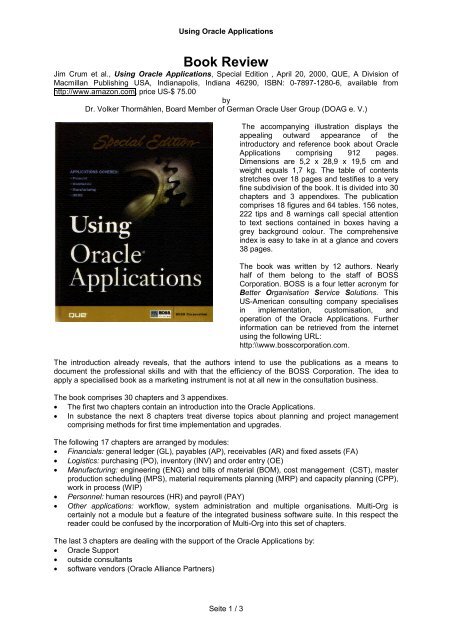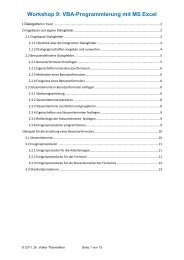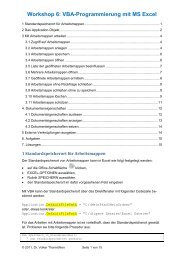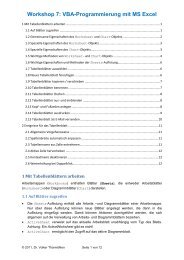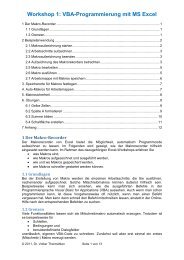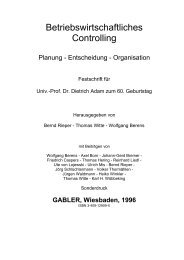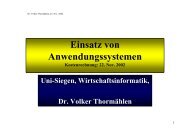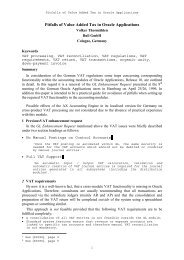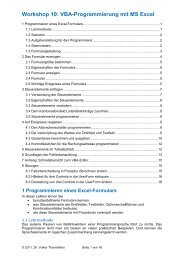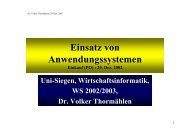Book Review - Dr. Volker Thormählen
Book Review - Dr. Volker Thormählen
Book Review - Dr. Volker Thormählen
You also want an ePaper? Increase the reach of your titles
YUMPU automatically turns print PDFs into web optimized ePapers that Google loves.
Using Oracle Applications<br />
<strong>Book</strong> <strong>Review</strong><br />
Jim Crum et al., Using Oracle Applications, Special Edition , April 20, 2000, QUE, A Division of<br />
Macmillan Publishing USA, Indianapolis, Indiana 46290, ISBN: 0-7897-1280-6, available from<br />
http://www.amazon.com, price US-$ 75.00<br />
by<br />
<strong>Dr</strong>. <strong>Volker</strong> Thormählen, Board Member of German Oracle User Group (DOAG e. V.)<br />
The accompanying illustration displays the<br />
appealing outward appearance of the<br />
introductory and reference book about Oracle<br />
Applications comprising 912 pages.<br />
Dimensions are 5,2 x 28,9 x 19,5 cm and<br />
weight equals 1,7 kg. The table of contents<br />
stretches over 18 pages and testifies to a very<br />
fine subdivision of the book. It is divided into 30<br />
chapters and 3 appendixes. The publication<br />
comprises 18 figures and 64 tables. 156 notes,<br />
222 tips and 8 warnings call special attention<br />
to text sections contained in boxes having a<br />
grey background colour. The comprehensive<br />
index is easy to take in at a glance and covers<br />
38 pages.<br />
The book was written by 12 authors. Nearly<br />
half of them belong to the staff of BOSS<br />
Corporation. BOSS is a four letter acronym for<br />
Better Organisation Service Solutions. This<br />
US-American consulting company specialises<br />
in implementation, customisation, and<br />
operation of the Oracle Applications. Further<br />
information can be retrieved from the internet<br />
using the following URL:<br />
http:\\www.bosscorporation.com.<br />
The introduction already reveals, that the authors intend to use the publications as a means to<br />
document the professional skills and with that the efficiency of the BOSS Corporation. The idea to<br />
apply a specialised book as a marketing instrument is not at all new in the consultation business.<br />
The book comprises 30 chapters and 3 appendixes.<br />
• The first two chapters contain an introduction into the Oracle Applications.<br />
• In substance the next 8 chapters treat diverse topics about planning and project management<br />
comprising methods for first time implementation and upgrades.<br />
The following 17 chapters are arranged by modules:<br />
• Financials: general ledger (GL), payables (AP), receivables (AR) and fixed assets (FA)<br />
• Logistics: purchasing (PO), inventory (INV) and order entry (OE)<br />
• Manufacturing: engineering (ENG) and bills of material (BOM), cost management (CST), master<br />
production scheduling (MPS), material requirements planning (MRP) and capacity planning (CPP),<br />
work in process (WIP)<br />
• Personnel: human resources (HR) and payroll (PAY)<br />
• Other applications: workflow, system administration and multiple organisations. Multi-Org is<br />
certainly not a module but a feature of the integrated business software suite. In this respect the<br />
reader could be confused by the incorporation of Multi-Org into this set of chapters.<br />
The last 3 chapters are dealing with the support of the Oracle Applications by:<br />
• Oracle Support<br />
• outside consultants<br />
• software vendors (Oracle Alliance Partners)<br />
Seite 1 / 3
Using Oracle Applications<br />
Complementary software products of 64 partner companies are described in sufficient detail. Contact<br />
name, phone, e-mail and web-page are specified in each case. For US-American readers this chapter<br />
(comprising 65 pages) is probably of particular interest.<br />
The first two appendixes describe the Oracle employment market and the Oracle consulting market in<br />
the USA. On 6 pages the last appendix presents a checklist for Oracle Applications implementation<br />
showing more than 100 bullet point entries. If a company’s decision-maker or a consultation client<br />
complains about too high implementation cost and/or too long implementation duration, this check-list<br />
could be searched in order to find realistic opportunities for cost-cutting and to discuss corresponding<br />
consequences.<br />
For the description of the modules in the middle part of the book 31 pages are required per chapter on<br />
average. This seems to be sufficient to gain a general functional view, but presupposes some previous<br />
knowledge. A uniform description scheme is not applied to the modules as a rule. But the following<br />
headings are used in most of the chapters:<br />
• Introduction<br />
• Relationship to other applications<br />
• Discovering new features in release 11<br />
• Critical implementation factors<br />
• Configuring the application<br />
• Processing transactions<br />
• Understanding key reports<br />
• Summary and/or troubleshooting<br />
Surprisingly a functional description of the rather complex Project Accounting (PA) module is not<br />
included in the book. Just this complexity would have necessitated its consideration. Thus the<br />
presentation of the subsidiary ledgers within the Financials domain is incomplete.<br />
20 notes and 29 tips are allotted to the AR module. This is more than in all other descriptions of the<br />
modules, although the relative difficulty index of AR is only 90 (see table 4.2, p. 50). The relative<br />
difficulty index of the OE module is stated to amount to 170. Thus more notes and tips could be<br />
expected in corresponding chapter. But that doesn’t happen. In spite of this disproportion the full<br />
understanding of the notes, tips and warnings is not always easy for beginners.<br />
For 12 modules (GL, AP, AR, PO, INV, OE, ENG, BOM, CST, MPS/MRP, CPP and WIP) the<br />
interfaces are explained by figures showing input-output-relationships. For unknown reasons such a<br />
figure is not included for the FA module. 5 figures are utilised for illustration of the multiple<br />
organisations feature of the software package. 1 figure exhibits the business process for overdue<br />
customer invoices. The set-up steps, the profile options and sometimes the key reports are presented<br />
in tabular form. An index of figures and tables is not included. An index of bibliographical data and a<br />
glossary of technical terms are also missing.<br />
The explanation (107 pages) of the HR and PAY module accounts for 12 percent of all pages. In this<br />
context the authors of the book are writing the following (see p. 50): „The HR/PAY applications are<br />
very complex and often use a different method for implementation. A complex payroll implementation<br />
can take more than five times the effort of a General Ledger. Your situation might vary.“ In spite of this<br />
complexity European users will have only limited interest in the PAY module, because labour and<br />
social security regulations as well as labour contracts between employees and management will<br />
usually prevent a good fit. In general European business requirements (Value Added Tax for<br />
example), which can be covered by the standard product to a certain extent, are not treated in detail.<br />
The book is less suitable for readers performing a functional and/or technical support task or working<br />
as an Oracle Applications functional expert, because useful in-depth information is not available.<br />
Disregarding the desire of BOSS to become public knowledge the contents of the book is aiming at<br />
middle management within the functional departments, which wants to gain a general knowledge of<br />
the scope and profundity of functions making up the Oracle Applications. For this purpose it is certainly<br />
appropriate, provided that the reader is acquainted with English technical terms and the so-called<br />
Oracle jargon, for example AutoAccounting, FlexField or QuickCode. Accordingly the reverse side of<br />
the hardcover correctly recommends: „User Level: Intermediate – Advanced“. Compared to the „Functional<br />
Overviews“ published on CD-ROM by Oracle the book has the advantage, that critical opinions<br />
Seite 2 / 3
Using Oracle Applications<br />
can be read here and there. In the introductory chapters for example misdirected developments and<br />
quality issues are stated frankly (see “Admitting Mistakes”, p. 13). In addition, under headings like<br />
“Proposed Enhancements“, important enhancement requests of the user community are quoted (for<br />
example on pp. 168, 520, 530).<br />
Without regard to described limitations the acquisition of the book can be recommended. If the reading<br />
enables a more reliable judgement about the suitability of the modules for specific business<br />
requirements and/or if only 1 fundamental set-up mistake can be avoided, the acquisition price (US-$<br />
75,00) will be regained many times.<br />
<strong>Dr</strong>. <strong>Volker</strong> Thormählen can be contacted at volker.thormaehlen@doag.org<br />
Seite 3 / 3


